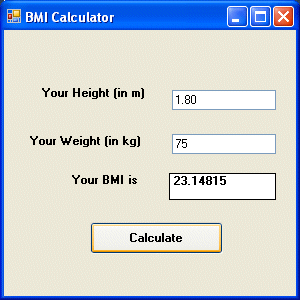In this program, you need to insert two Textboxes, four labels and one button. Click the button and enter the code as shown below. When you run the program, it will perform the four basic arithmetic operations and displays the results on the four labels.
Private Sub Button1_Click(ByVal sender As System.Object, ByVal e As System.EventArgs) Handles Button1.Click Dim num1, num2, difference, product, quotient As Single num1 = TextBox1.Text num2 = TextBox2.Text sum=num1+num2 difference=num1-num2 product = num1 * num2 quotient=num1/num2 Label1.Text=sum Label2.Text=difference Label3.Text = product Label4.Text = quotient End Sub
Example 7.2
The program can use Pythagoras Theorem to calculate the length of hypotenuse c given the length of the adjacent side a and the opposite side b. In case you have forgotten the formula for the Pythagoras Theorem, it is written as
c^2=a^2+b^2
Private Sub Button1_Click(ByVal sender As System.Object, ByVal e As System.EventArgs) Handles Button1.Click Dim a, b, c As Single a = TextBox1.Text b = TextBox2.Text c=(a^2+b^2)^(1/2) Label3.Text=c End Sub
Example 7.3: BMI Calculator
A lot of people are obese now and it could affect their health seriously . Obesity has proven by the medical experts to be a one of the main factors that brings many adverse medical problems, including the the cardiovascular disease. If your BMI is more than 30, you are considered obese. You can refer to the following range of BMI values for your weight status.
Underweight = <18.5
Normal weight = 18.5-24.9
Overweight = 25-29.9
Obesity = BMI of 30 or greater
In order to calculate your BMI, you do not have to consult your doctor, you can just use a calculator or a home made computer program, this is exactly what I am showing you here. The BMI calculator is a Visual Basic program that can calculate the body mass index, or BMI of a person based on the body weight in kilogram and the body height in meter. BMI can be calculated using the formula weight/( height )^2, where weight is measured in kg and height in meter. If you only know your weight and height in lb and feet, then you need to convert them to the metric system (you could indeed write a VB program for the conversion).
Private Sub Button1_Click(ByVal sender As System.Object, ByVal e As System.EventArsgs) Handles Button1.Click Dim height, weight, bmi As Single height = TextBox1.Text weight = TextBox2.Text bmi = (weight) / (height ^ 2) Label4.Text = bmi End Sub
The output is shown in the figure below. In this example, your height is 1.80m( about 5 foot 11),your weight is 75 kg( about 168Ib), and your BMI is about 23.14815. The reading suggests that you are healthy. (Note; 1 foot=0.3048, 1 lb=.45359237 kilogram)

From the above examples, you can see that writing code that involve arithmetic operations is relatively easy. Here are more arithmetic projects you can try to create the relevant VB programs:
Area of a triangle Area of a rectangle Area of a circle Volume of a cylinder Volume of a cone Volume of a sphere Compound interest Future value Mean Variance Sum of angles in polygons Conversion of lb to kg Conversion of Fahrenheit to Celsius

